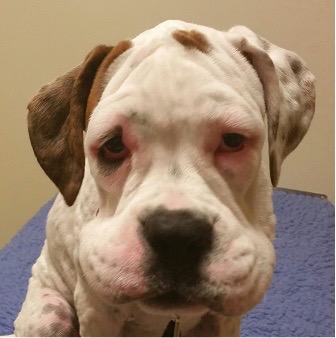If your dog got stung by a bee in the face, monitor for signs of an allergic reaction, such as swelling, difficulty breathing, or vomiting. Seek veterinary care if symptoms worsen or persist. Dealing with a bee sting on your dog’s face can be concerning, but knowing how to handle the situation can help alleviate your pet’s discomfort and prevent further complications. When a dog gets stung by a bee, it may cause pain, redness, and swelling at the site of the sting.
It’s crucial to stay calm and assess the situation to determine if your dog is experiencing an allergic reaction. We’ll discuss the steps to take when your dog gets stung by a bee in the face and offer tips on how to prevent future stings.

Signs Of A Bee Sting On A Dog
If your furry friend has ever encountered a bee, you know how curious dogs can be. Unfortunately, this curiosity can often lead to a bee sting. Just like humans, dogs can experience discomfort and irritation from bee stings. It’s important to recognize the signs of a bee sting on your dog so you can provide them with the appropriate care and attention they need. Here are some common signs to look out for:
Swelling
One of the most noticeable signs of a bee sting on a dog is swelling. When a dog gets stung by a bee, the area where the sting occurred may become swollen. This swelling can range from mild to severe, depending on the dog’s sensitivity to the venom. Keep an eye out for any abnormal bulges or puffiness, especially on the face, as this is a common area for dogs to get stung.
Pain
Bee stings are painful for dogs just as they are for humans. Your dog may exhibit signs of discomfort or pain after being stung. They may whimper, cry, or even try to lick or scratch the affected area. If you notice your dog acting unusually agitated or restless, it could be a sign that they are in pain from a bee sting.
Redness
In addition to swelling and pain, redness is another common sign of a bee sting on a dog. The area around the sting may appear redder than usual, indicating inflammation. Redness can be accompanied by heat in the affected area, which further indicates that your dog has been stung by a bee. Be sure to gently examine your dog’s skin for any unusual or intense redness.
It’s important to remember that if your dog has been stung by a bee, they may exhibit a combination of these signs or even additional symptoms such as itching or difficulty breathing. If you suspect your dog has been stung by a bee and is experiencing an allergic reaction or severe symptoms, it’s crucial to seek immediate veterinary attention.
What To Do When Your Dog Gets Stung
If your dog has been stung by a bee, it can be a distressing experience for both you and your furry friend. Knowing how to respond can make a significant difference in helping your dog feel more comfortable and recover quickly. Here are the essential steps to take when your dog gets stung by a bee.
Stay Calm
Try to stay calm and reassure your dog with a soothing voice and gentle petting. Dogs can pick up on their owners’ emotions, so maintaining a sense of calm will help to keep your pet calm as well.
Remove The Stinger
Inspect the affected area and carefully remove the stinger from your dog’s skin as soon as possible. Use a pair of tweezers and ensure that you do not press the stinger, as this can release more venom into the skin.
Apply A Cold Compress
Once the stinger is removed, apply a cold compress to the affected area to reduce swelling and alleviate any discomfort your dog may be experiencing. You can use a clean cloth soaked in cold water or a cold pack wrapped in a towel.
When To Seek Veterinary Help
If your dog has been stung by a bee on the face, it’s best to seek veterinary help immediately to ensure proper treatment and reduce the risk of any complications. Acting promptly can help your furry friend recover quickly and stay healthy.
When to Seek Veterinary Help If your dog has been stung by a bee, it’s essential to monitor their condition. Be aware of when to seek veterinary help. While most bee stings are not a cause for major concern, certain situations require immediate medical attention. Allergic Reactions If you notice signs of an allergic reaction such as swelling beyond the immediate sting site, hives, vomiting, or diarrhea, it’s crucial to seek veterinary help promptly. Allergic reactions to bee stings can escalate rapidly and may become life-threatening if left untreated.
Multiple Stings If your dog has been stung multiple times, especially on sensitive areas such as the face, mouth, or throat, it’s important to consult a veterinarian. Multiple stings can lead to a more severe reaction and may require medical intervention to ensure your dog’s well-being. Difficulty Breathing If your dog experiences difficulty breathing after being stung by a bee, it is a medical emergency, and you should seek immediate veterinary assistance.
Difficulty breathing can indicate a severe allergic reaction and prompt treatment is essential to ensure your dog’s respiratory health. In any of these situations, it’s best to err on the side of caution and seek veterinary help to ensure that your furry companion receives the necessary care for a smooth recovery.

Credit: www.treendalevet.com.au
Home Remedies For Bee Stings On Dogs
If your furry friend has had an unfortunate encounter with a bee and ended up with a sting on their face. You may be wondering how you can help ease their discomfort. While it’s important to consult your veterinarian for severe cases. Several home remedies can provide some relief for your beloved pup. Below are three effective options:
Baking Soda Paste
Making a baking soda paste is a simple yet effective way to alleviate the pain and swelling caused by a bee sting. Baking soda’s alkaline properties help neutralize the acidic venom. To create the paste, follow these steps:
- In a small bowl, mix one tablespoon of baking soda and a few drops of water.
- Add just enough water to form a thick paste.
- Apply the paste directly to the sting using a clean cloth or your fingertips.
- Leave the paste on for around 10 minutes before gently wiping it off with a damp cloth.
Repeat this process two to three times a day until your dog’s symptoms improve.
Honey
Honey is a natural antibacterial and anti-inflammatory agent that can help soothe a bee sting. It has been used for centuries as a remedy for various ailments, including insect bites. To use honey as a home remedy for your dog’s bee sting:
- Dab a small amount of organic, raw honey onto the sting area.
- Let it sit for about 15 minutes.
- Gently rinse off the honey with water.
- Repeat this process two to three times a day until your dog shows signs of improvement.
Remember to use organic, raw honey as it retains the most beneficial properties.
Aloe Vera
Aloe vera is well known for its cooling and soothing properties, making it an excellent choice for relieving the discomfort of a bee sting. To use aloe vera on your dog’s sting:
- Extract the gel from an aloe vera leaf by cutting it open.
- Apply a small amount of the gel directly onto the sting site.
- Gently massage the gel into the skin for a few minutes.
- Let the gel air dry on the skin.
Repeat this process two to three times a day until your dog’s symptoms subside. However, if your dog shows any signs of an allergic reaction or if the swelling worsens, consult your veterinarian immediately.
Preventing Bee Stings On Dogs
Keeping your furry friend safe from bee stings is essential to their well-being and can save you from unnecessary panic and trips to the vet. When a dog gets stung by a bee, it can be a painful experience for them, especially if the sting is on their face. With a few preventative measures, you can minimize the risk of your dog getting stung and ensure their safety.
Keep Dogs Away From Bees
To prevent your dog from getting stung, it’s important to keep them away from bees as much as possible. Bees are naturally attracted to flowers and sweet smells, so make sure you don’t allow your dog to sniff or play around flower beds. Additionally, avoid walking your dog near beehives or areas with a high bee population. By keeping your dog away from bees, you can significantly reduce the chances of them getting stung.
Avoid Fragrances
Many dogs are attracted to strong fragrances, so it’s best to avoid using perfumes, scented lotions, or any products with overwhelming smells. Bees are naturally drawn to these scents, and your dog’s curiosity may lead them straight to a bee, increasing the risk of a sting. Stick to unscented products when grooming your dog to minimize their attraction to bees and decrease the likelihood of stings.
Inspect The Yard Regularly
Regularly inspecting your yard for potential bee nests or hives is essential in preventing bee stings. Walk around your property and look for areas where bees might be nesting, such as tree branches, cracks in walls, or any sheltered spots. If you find active nests or hives, contact a pest control professional to safely remove them from your property. By proactively inspecting your yard, you can eliminate potential bee habitats and provide a safer environment for your dog.
Credit: www.prouddogmom.com
FAQ Of My Dog Got Stung By A Bee In The Face
Can A Bee Sting On A Dog’s Face Be Dangerous?
Yes, a bee sting on a dog’s face can be dangerous as it can cause swelling, pain, and even an allergic reaction. It is important to monitor your dog closely. And seek veterinary care if symptoms worsen or if your dog shows signs of allergies. Such as difficulty breathing or excessive swelling.
How Can I Help My Dog If It Gets Stung By A Bee In The Face?
If your dog gets stung by a bee in the face, you can help by removing the stinger if it is visible. And applying a cold compress to reduce swelling. Keep an eye out for any allergic reactions or signs of distress. And consult with a veterinarian for further guidance and treatment if needed.
Are There Any Home Remedies For A Dog’s Bee Sting On The Face?
While some home remedies can provide temporary relief for a dog’s bee sting on the face, it is important to consult with a veterinarian for proper guidance. Some remedies include applying a mixture of baking soda and water to the affected area or giving your dog a small amount of Benadryl, but always consult a professional before trying any home remedies.
Conclusion
Dealing with a bee sting on your dog’s face can be a worrying experience. However, by promptly addressing the issue and providing the necessary care, you can help your furry friend recover quickly. It’s crucial to monitor any signs of allergic reactions and consult your veterinarian if needed.
Remember to keep an eye on your dog during outdoor activities to prevent future encounters with bees. With some caution and care, your dog will be back to wagging its tail in no time!



